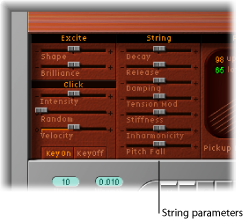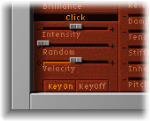Working with EVD6 Model Parameters
The EVD6 is a physically modeled instrument—where individual aspects of the original D6 are analyzed and mathematically recreated. This includes the string materials and length, the age and condition of the hammers, and so on.
You have control over these elements in the EVD6 sound engine and can use them to create extremely detailed and accurate emulations of not only the D6, but also other stringed instruments, such as harpsichords and guitars.
You can also take advantage of these parameters to create a range of sounds that have very little in common with a clavinet.
This section discusses the selection of an instrument model and the model editing parameters.
Choosing an EVD6 Model
The Model pop-up menu allows you to choose a basic type of tone, or model. To open the Model pop-up menu, click the model name to the left of the Level knob. Each model offers a unique tonal characteristic and different harmonic structure, designed to create very different sounds.
The individual models are fully realized instruments and are immediately playable, without further modification. You are, of course, free to shape the tonal character of any loaded model with the EVD6 model editing parameters.

In some respects, you can view the choice of model as being much like selecting an oscillator waveform in a synthesizer. As with raw synthesizer waveforms, the editing parameters can affect the model quite differently. For example, using identical parameter settings can make one model more nasal sounding and another model more noisy.
EVD6 Model Characteristics
This section describes the characteristics of each clavinet model.
Model name | Comments |
|---|---|
Classic D6 | A near exact emulation of the original D6. It includes string noises on long decays and accurate behavior following the release of keys. Each D6 was unique in its way, so feel free to adjust the sound in order to match the tone of D6 clavinets that you have heard. |
Old D6 | This model emulates a well-worn D6. Hammers and strings are a bit aged and worn. The sound of the sticky hammer heads is emulated, as well as the typically richer sound in the bass range. |
Sharp D6 | Very sharp with a lot of bite—nice with wah wah and phaser. |
Mello(w) D6 | As the name suggests, a mellow fellow—across the entire keyboard range. |
Basic | Basic, simple clavinet with no special characteristics. |
Domin(ation) | A powerful model with a strong and punchy attack—reacts more aggressively to velocity than other models. |
GuruFnk (Guru Funk) | In the lower bass-octave ranges, the string oscillations become increasingly resonant over time, until they finally collapse (after 20 to 30 seconds). Higher notes have a much shorter decay, which has a corresponding impact on the resonating behavior. This model invites heavy, funk-style bass playing in the lower octaves. It’s nice with a little phaser, and sustained chords, when playing low bass notes. Adding a Delay plug-in is also a great option. |
Harpsi(chord) | Harpsichord-like model. |
Pluck | Plucked string. Changing pickup positions makes the sound more guitar-like. Harp-style sounds are also possible, by positioning the lower pickup near the mid point of the Pickup window. To obtain a harp-like sound, increase String Decay, Release, and Excite Shape—while decreasing Excite Brilliance parameters. |
(Tuned) Wood | Somewhat wooden, thin, and with some inharmonic overtones. Can sound slightly detuned in some contexts. |
Ltl (Little) India | Sitar-like sound, rich in resonance. |
S(tring) Bells | A bell model with strong inharmonic overtones (inharmonicities). |
Dulcimer | Dulcimer-like model. |
Picked | This model emulates a picked nylon string. |
Setting EVD6 String Parameters
The selected model determines the basic behavior of the strings and has a significant bearing on the behavior, and impact, of each String parameter. This is primarily due to the different harmonic content present in each model.

- Damping slider: Modifies the damping behavior of the strings. Damping is essentially a faster decay for the higher harmonics in a sound, and is directly related to the string material properties—high damping for catgut strings, medium damping for nylon strings, low damping for steel strings. Sonically, damping results in a more mellow and rounded, or woody, sound, depending on the model used. A positive Damping value will make the sound more mellow, and a negative value will allow more of the high harmonics through, making the sound brighter.
- Tension Mod slider: Adds a slight upward pitch bend effect to the strings, immediately after being plucked, struck, or strummed. This type of modulation is common to all stringed instruments, like the D6, guitars, and so on. A predefined Tension Modulation characteristic is built into each model, but this can be altered with the Tension Mod parameter. The impact of this parameter can be significant, enabling you to obtain weird sound effects from the EVD6. You can also use it to simulate an out-of-tune clavinet, or as a quick-and-dirty sitar sound, for those “Norwegian Wood” covers.
- Stiffness and Inharmonicity sliders: The Inharmonicity parameter determines the lowest harmonic—the harmonic threshold. Inharmonic content above this threshold is stretched or spread across the frequency spectrum. The Stiffness parameter controls the intensity of the stretching or spectral spreading set by the Inharmonicity slider.
The Stiffness and Inharmonicity parameters enable you to intensify or reduce the strength of the inharmonic content in the sound. When combined at different levels, these parameters can create metallic, bell-like sounds, or DX-like electric piano-style sounds. They can also be useful for wood bass sounds.
The fundamental note pitch is not affected by the Stiffness and Inharmonicity parameters.
- Pitch Fall slider: Provides control over a characteristic of the original D6, where the pitch of each note falls immediately after you release the key. This sonic quirk is due to the physical construction of the D6. The intensity of this effect varies with each model, but it can be completely deactivated by setting this slider to the leftmost position.
Setting EVD6 Excite Parameters
These parameters describe the string excitation. In other words, they are used to emulate the characteristics and power of the hammers striking the string, and other elements that form part of the initial key strike.

- Shape slider: Contours the attack shape, allowing you to simulate the hardness of the rubber hammers in an original D6. As the instrument ages, the hammers become worn, split, and so on, which has an impact on the overall brightness and tone. Negative values—to the left—provide a softer attack, and positive values result in a harder attack.
Setting EVD6 Click Parameters
The rubber hammers of the original D6 age and decay, just like piano hammer felts. Well-loved, worn out, D6 units produce a distinctive “click” when a key is released. This is due to the string sticking to the rubber hammer before being released. The characteristics of this release click are part of each model and can be precisely adjusted with the following parameters.

- Random slider: Controls the amount of click-level variance across the keyboard. This slider simulates the wearing of some hammers, but not others, emulating the real-world “wear and tear” of the original D6. The farther to the right the slider is moved, the greater the variation between key clicks on some keys. At the leftmost position, all keys have an identical key click level.
- KeyOn and KeyOff buttons: These buttons are used to select the type of velocity information that is used as a modulation source for the release click level.
Choose the KeyOn button to use attack velocity—how hard you hit the keyboard—as the modulation source value for the key click.
Choose the KeyOff button to use release velocity—how quickly you release the keys on your keyboard—to determine the level of the key click. (KeyOff requires a keyboard with release velocity facilities.)
Note: The Velocity parameter must be set to a reasonable level for the KeyOn/KeyOff modulation to be easily heard.